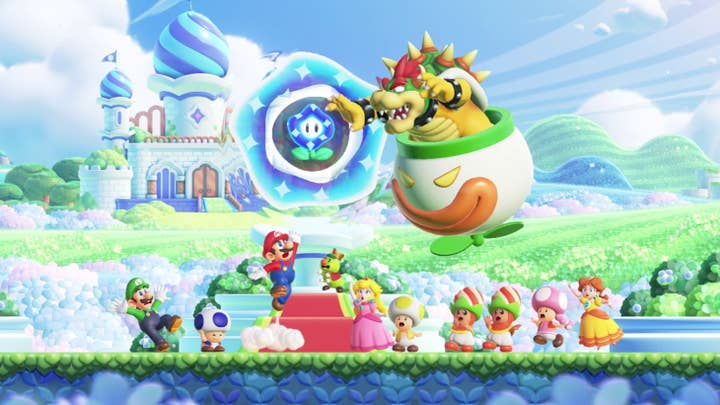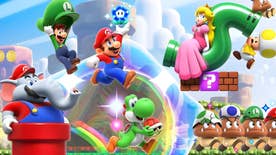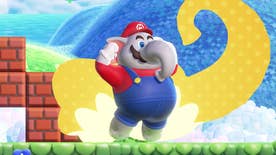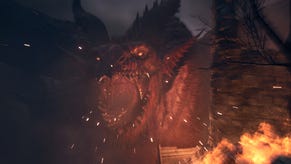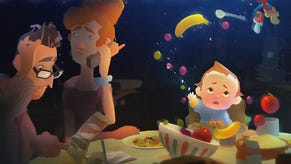Super Mario Bros Wonder | Critical Consensus
Critics call Mario's latest adventure a nostalgic return to form
After exploring an open-world formula with Super Mario Odyssey, Nintendo's flagship IP has returned to its platforming roots with Super Mario Bros Wonder, releasing today.
Aside from Super Mario Maker and mobile title Super Mario Run, it's been over a decade since players have been able to jump and break blocks in a new title as Nintendo's mascot.
As of writing, Mario Wonder has a Metacritic score of 93 out of 53 reviews, and it seems that critics have fallen for its reinvention of the franchise's platform formula.
In his 5/5 review for VG247, Alex Donaldson heralded the game as "the best 2D Mario game since the franchise's 16-bit heyday" and "a worthy sequel to Super Mario World."
GamesRadar+'s Sam Loveridge agreed, calling Mario Wonder "the most creative 2D Mario adventure we've had in a long time." Loveridge compared the magic of playing Mario Wonder to going to Disneyland for the first time.
"You have no idea what's beyond that first bend on the roller coaster track or behind the next closed door, but there may well be sudden singing, odd little creatures, and the occasional man in an oversized suit," she wrote in her 4.5/5 stars review.
"Mario Wonder is the most creative 2D Mario adventure we've had in a long time"Sam Loveridge
Both found joy in Mario Wonder's art style, which Donaldson described as "new, but also old and familiar." He also noticed an influence from the Super Mario Bros Movie, which has since grossed $1 billion at the global box office and become the highest-grossing video game film adaptation.
Loveridge described Mario Wonder as "easily the prettiest Mario adventure yet, with an overall level of sheen and finish that really sets this game apart from its predecessors." She also noticed the level of detail in this game, which heightened the "magic and playfulness" of the Mario franchise.
"There's so much to spot, whether it's the snot bubble on a sleeping Goomba or the fact each character's face changes when they start dashing," she wrote.
While there are 12 characters for players to choose from in Mario Wonder, their unique abilities are nowhere to be found.
"They all play exactly the same way. It feels like a wasted opportunity when there are so many characters available," Loveridge surmised.
Fans of Yoshi and Nabbit will also be disappointed, as they can't use power-ups.
"These characters are intended as beginner-friendly options, but the power-ups are such a core part of the Mario experience it does feel really restrictive," Loveridge wrote. "As a huge Yoshi fan, I'd rather have the option to toggle that specific feature manually rather than having it locked to specific characters."
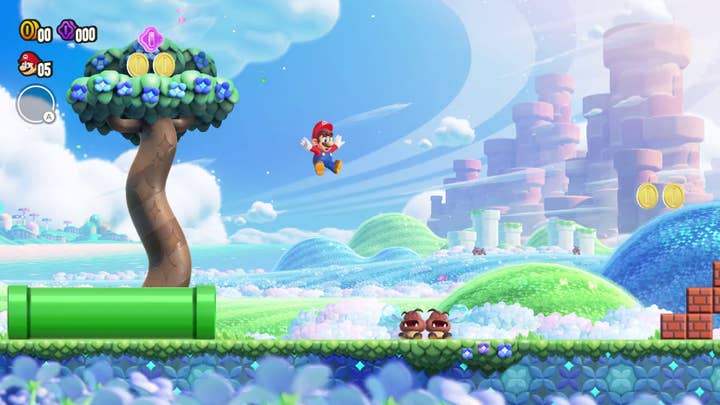
Mario Wonder has a new mechanic in badges, which provide skills and abilities outside of power-ups. Donaldson described them as "an intriguing and rather clever addition" that benefit beginners greatly.
"Others, however, are clearly aimed at the aficionados, like augmenting the nature of your jump or wall-jump," he continued.
Digital Spy's Jess Lee, who gave the game 3.5/5 stars, found only being able to equip one badge at a time to be "quite restricting," especially when, as Loveridge noted, some of these badges are "classic Mario abilities" such as the crouch to high jump.
Managing the badges is just as tedious, Lee explained: "You can only swap badges between levels, so if you happen to have a badge equipped that's useless for the course, you either have to exit the level or play through without any advantage."
Lee felt that Nintendo treated "these abilities as just another gimmick instead of making them a core part of the controls." And while Loveridge acknowledged that this mechanic does "aid approachability for a whole range of players," she felt it was "definitely the weakest element of what is otherwise an excellent package."
Wonder Flowers are the core of Mario Wonder. The game centres around this new item which, once interacted with, can flip a level on its head (quite literally) and drastically change its design and mechanics. Donaldson initially saw them as a gimmick, but the more he played, "the more that paradigm shifted."
"The deeper you get, the more zany and unique many of the effects become," he observed. "As you reach later levels, Nintendo knows you'll understand the physics and rules of the game well enough that it can really begin to mess with you. This doesn't just mean new challenges, either, but rather that Mario Wonder is frequently delightfully funny — embedding little moments of comedy into the way in which its world unfurls into chaos."
There are only so many effects the Wonder Flower can produce, but "there's a magic to unleashing every one," Loveridge wrote.
"At the game's worst, the levels are disconnected and lack cohesion, resulting in an experience that feels aimless"Jess Lee
"Missing a Wonder Flower for me is an instant level restart too, as I just can't bear the thought of not experiencing whatever slice of silliness that level was waiting to deliver, " she said.
Mario Wonder features six worlds, each featuring levels themed to the area they reside in. Loveridge highlighted that while the themed worlds are expected in a Super Mario game such as this, "the Wonder Flowers keep things feeling fresh even if the idea of an ice-themed world is one that many Mario games have traversed before."
Nintendo's effort in ensuring each level is unique didn't go unnoticed by Lee either, but she found that this caused issues with the overarching structure.
"The consequence of that is there is barely a through-line in many of the worlds," she noted. "Levels in a world may share a similar colour palette, but they often don't feel like they're part of the same world. At the game's worst, the levels are disconnected and lack cohesion, resulting in an experience that feels aimless."
That said, Lee found that "when a course works, it really does work – and that's thanks to one of the series' greatest strengths: its tight controls."
Those controls are something that Donaldson praised, highlighting the animation and changes in physics that directly impacted the smoothness of the game.
"Specifically, the action feels more precise and less slippery," he explained. "You can stop much more quickly now, bringing things back in line with the feel of the NES and SNES games."
Overall, Donaldson concluded that Mario Wonder "isn't just a good game: it stands amidst a blisteringly glowing pantheon of platforming gaming. And, in many ways, it's a return to form."
He reflected on how "past and present meet in a rare display of beautifully balanced game design chemistry," making the game "one of the easiest recommendations of the year in an incredibly stacked year."
Lee was more critical of the game, but could see what Nintendo was trying to achieve.
"It isn't just a good game: it stands amidst a blisteringly glowing pantheon of platforming gaming"Alex Donaldson
"Mario Wonder is too disjointed to be considered a classic, often not making the most out of its best ideas," she wrote. "It's scatterbrained approach and the over-reliance on gimmicks needed to have been reined in a little, so that Mario's latest outing could feel more consistently like an adventure than a series of unconnected levels."
She added: "It's a game that tries to evoke a feeling of discovery at every possible turn, but in doing so loses the element of wonder fairly quickly. Instead, Wonder's strongest moments are when it takes a breather, taking the time to set the scene while letting the platforming do the talking."
Sign up for the GI Daily here to get the biggest news straight to your inbox
